Our Grammy Moment
An odd calm has fallen over the Staples Center. It's Saturday afternoon, day three of rehearsals leading up to the Grammy Awards on Sunday night. It's my second year to receive a behind-the-scenes look at the show's technical HD production, and this year's low-key vibe stands in stark contrast to the palpable tension I felt last year, when few people had time for an extended conversation. Interview time has been generous this year, and I've already been on site for over an hour when we finally make our way into the arena itself.

This year's Grammy Awards presentation was held at The Staples Center in Los Angeles. • •
A furtive glance at the day's schedule has revealed that the Police will be rehearsing in another hour and a half. I wonder, can I think up enough technical questions to keep my tour guide occupied for that long? No, I suspect not. He has already been more than generous with his time, and I must be content to spend the next 15 minutes watching Ludacris rehearse his song "Runaway Love" with Mary J. Blige and Earth, Wind & Fire. Even though I'm not a follower of rap or R&B, as a music lover, I can't help but be taken in by the performance—so much so that I would still find myself humming it a week later.
And therein lies the allure of the Grammys: its exposure. Whether you agree with the Recording Academy's nominees and ultimate winners each year, there's no denying that the Grammy telecast is the biggest musical event of the year, bringing together artists from a wide range of musical genres to perform before an audience of millions. Even the Academy has realized that the awards are secondary to the musical celebration; in this year's show, the number of performances outnumbered the award presentations by almost two to one, and an average of 19 million viewers tuned in.
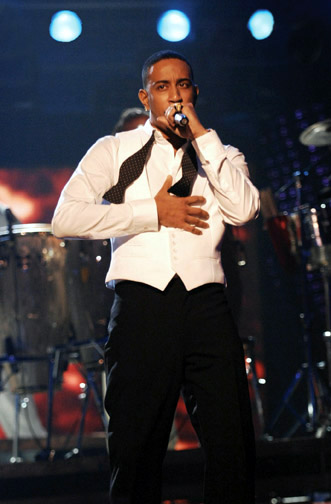
Ludacris performs "Runaway Love." ‡
It's not just the size of the audience, either; it's the diversity. Artists know that this is the stage to introduce their music to the uninitiated. I may tune in to the see the Police reunion, but I'll stay to hear performances by the Dixie Chicks, Mary J. Blige, Shakira, and Chris Brown—artists not to be found in my music collection. For the past two years, worthy Grammy performances have sent me to the iTunes Store to purchase music, and I'm not alone. As I write this several days after the show, the songs performed by Justin Timberlake and the Dixie Chicks sit atop the iTunes Store's list of top downloads.
So, I'm hardly surprised when, a few minutes later, I find Ludacris' management reps hanging out in the XM Productions Music Truck, dubbed the L7, listening to take three of the rehearsal from this perspective. Sure, it's important that the performance sound great in the arena, but even more important is how music mixer Eric Schilling and the rest of the technical crew will make it sound for the real audience, those millions of music fans on the other side of the TV screen.

In the XM Productions Music Truck, mixer Eric Schilling (left) captures Ludacris' rehearsal of "Runaway Love."
Mix It Up
This year's broadcast marks the fifth time the Grammy Awards have been presented in high definition with a Dolby Digital 5.1 soundtrack. Each year, the goal is simple: To make it better. High-quality video is obviously a desired trait; the night of the show, 17 HD cameras will capture the event live. As I pay a visit to the camera platform at the center of the arena, I ask the three stationary-camera operators what they consider the biggest challenge of a show like this, and they seem to be in agreement: all of the rehearsing. These guys will attend four days of rehearsal leading up the show to ensure that they're prepared to capture every moment in any artist's performance.
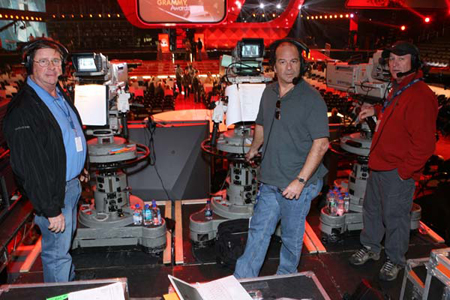
A total of 17 HD cameras covered the event, including three stationary cameras located at the center of the arena. • •
As important as the video quality is, audio is the heart of the Grammy telecast. Last year's production saw the introduction of a secondary mixing truck (dubbed the ORB, for Offline Remix Booth), identical to the L7, designed to give music mixers Eric Schilling and John Harris more time to perfect their mixes. (Check out our coverage of the 2006 show here.) The night of the show, each audio mix took two distinct paths: One became a stereo mix for the analog broadcast, and the other went to 5.1 surround sound mixer Paul Sandweiss for the dedicated Dolby Digital 5.1 mix. Those of us who enjoyed the CBS HD broadcast were treated to some amazing performances that sounded fantastic in surround. Clearly, the team had figured it all out, so I was a bit surprised to receive the behind-the-scenes invite again this year. What would we talk about? As I would soon learn, this year's audio challenge was not simply to produce a great-sounding show but to prepare the broadcast for the future.
A dedicated stereo mix may make perfect sense now, since a majority of viewers have not made the transition to HD. However, as I was reminded by almost every member of the production team during my tour, that February 2009 cutoff date for analog broadcasts is looming. The future is digital, and surround sound is an integral part of that future. As Dolby representative Rocky Graham explains, "In a couple of years, when the digital transition is complete, broadcasters are going to want to receive just one soundtrack, not 5.1 and stereo and LT/RT [Dolby Pro Logic II]. They will want one audio feed coming in. Then, if they need to derive other formats from it, they will."
In anticipation of this, the Grammy team decided to forego the conventional stereo mix this year, opting instead to create a Pro Logic II―encoded version of the surround music mix. Those people watching CBS HD still received Paul Sandweiss' dedicated 5.1 mix, while those watching the analog broadcast received a DPLII mix, created by a Dolby DP563 DPLII encoder and mixed by production mixer Tom Holmes.

Paul Sandweiss creates the show's dedicated 5.1 surround sound mix. • •
More significant than the change itself is the technical crew's attention to detail concerning all of the possible audio permutations of the broadcast. According to Hank Neuberger, who produced the audio for the first HDTV 5.1 broadcast and still serves as a co-audio supervisor for the Grammy telecast for the Recording Academy's Producers & Engineers Wing, CBS anticipates that 35 percent of this year's audience will watch the digital broadcast of the Grammy telecast, but that doesn't necessarily mean they'll listen to it in 5.1. The current audio landscape is a complicated one: Many HDTV owners have yet to embrace surround sound, and some audio lovers have made the switch to 5.1 but not HDTV. Do the math, and we're talking about at least four different ways the audience might listen to the show: the digital broadcast in 5.1 or stereo and the analog broadcast in 5.1 or stereo.
Last year's Grammy production placed a lot of emphasis on two of the four (digital 5.1 and analog stereo), but, this year, the team made a conscious choice to address all four. "This the first time we've paid this much attention to all of the different mixes out there," says audio coordinator Michael Abbott. "Experience has shown us that, if the multiple formats aren't paid attention to, you will have problems." Neuberger adds, "We're trying to anticipate how people will hear it at home so that we can make the balance more appealing for everyone. We've installed a considerable amount of Dolby processing gear at all the critical mix positions so our mixers can listen in every format."
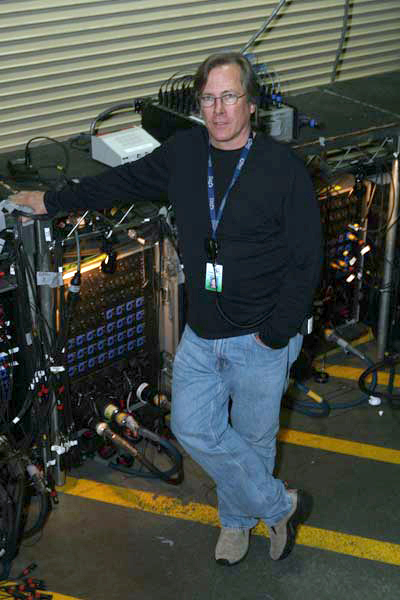
Audio coordinator Michael Abbott oversees the physical production of the audio broadcast. • •
That processing gear includes the Dolby DP570 multichannel audio tool, which emulates the different listening scenarios. A DP570 resides at each mixing station along the signal path, so any engineer in the chain—be it music mixers John Harris and Eric Schilling, production mixer Tom Holmes, 5.1 mixer Paul Sandweiss, audience reaction mixer Klaus Landsberg, or orchestral music mixer Joel Singer—can hear how a certain performance will sound in any given format. Says Rocky Graham, "The mixers have to understand that what they're creating is going to work in all those situations. In the future, they will not be the ones controlling that downmix process, so they need to get used to the tools and understand how they work."
When you consider that a lot of audiophiles make up the Grammy production team, the decision to permanently step away from two-channel isn't a small one, but it's one that the time has come for. "If it's for television or film today, there is no stereo anymore," Neuberger admits. "It's almost entirely LT/RT or some form of surround sound. We're all getting used to that and learning to make the most of it."
In My Room
I once asked a seasoned musician what wisdom he had gleaned from all his years in the industry. He responded without hesitation, "Don't piss off the sound guy." Whether it's at the dive bar on the corner or during the international telecast of the Grammy Awards, a performance is only as good as the audio mixer that brings it to life. Perhaps the only thing more powerful than the mixer himself is the room in which he works his magic.

Music mixers John Harris and Eric Schilling, hard at work. • •
In home theater circles, we've long emphasized the importance of a room's acoustic properties and how they affect your audio components. It's easy to forget that these issues are equally relevant, if not more so, on the production end. Music mixers rely on certain speakers, placed in a certain room with its own certain set of acoustic properties, to guide them in their work—a lesson the XM Productions team learned last year when they decided to add that second mixing truck. Even though the space was generally the same shape and size as the main truck and featured the exact same equipment, there was one noticeable difference. Orchestral music mixer Joel Singer explains, "Last year, we used another speaker for surround monitoring [in the mixing trucks]. It was a great speaker, but the differences tonally from room to room were obvious." The secondary truck, nicknamed the ORB, had a different acoustic character, which means a slightly there was a different-sounding mix in each space. Vocals that may sound a little too up-front or harsh in the practice room are suddenly too relaxed in the main truck.
Needless to say, this was undesirable for the music mixers, so the team made a change to the hardware lineup this year, replacing the existing speakers with Genelec's 8200 Series of professional sound monitors. These biamplified speakers featured digital AES connections that allow you to feed them directly into a Mac or PC (in this case, the team uses Macs exclusively) and employ Genelec's automated calibration software to thoroughly analyze the acoustic property of each space and tailor the speaker output accordingly. The team was quite pleased with the result. "Going back and forth from room to room, the sound is so much more cohesive as far as tonality goes," Singer says. "You're not sitting there second-guessing yourself, wondering, 'Was that vocal a little honky or wasn't it?' It's perfect, and the spatial image is perfect, as well."
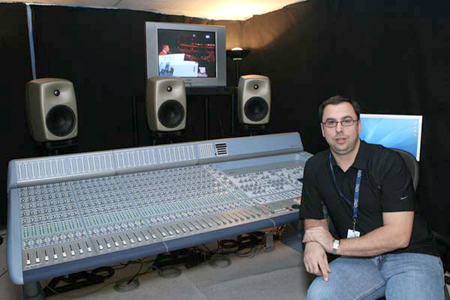
Orchestral music mixer Joel Singer lauds the addition of the Genelec 8200 Series speakers. • •
Talk About the Passion
Underneath all of this tech talk lies one ingredient that unites artist, technician, and viewer: a passion for music. The laid-back vibe during this year's tour gave me an opportunity to just talk about music and great Grammy moments with the crew, many of whom have worked on the show for over 20 years. Michael Abbott talks of Frank Sinatra's final performance and Melissa Etheridge's emotional Janis Joplin tribute in 2005 shortly after undergoing cancer treatment.
Hank Neuberger had no trouble recalling his favorite Grammy moment. After the 1998 telecast had already begun, Luciano Pavarotti informed the producers that his throat hurt and he could not sing his planned aria "Nessun dorma." Luckily for them, Aretha Franklin was already scheduled to perform that night and just so happened to have sung that aria to Pavarotti at a recent tribute. With no rehearsal and only a cassette of Pavarotti's dress-rehearsal performance as her guide, she took the stage and nailed the song in Pavarotti's key, earning a standing ovation. "It was an unbelievable moment," Neuberger tells us enthusiastically, "really one of the great ones."
That 1998 show had a few other classic Grammy moments, although they would fall more into the infamous category. It was the year Wu Tang Clan member ODB walked on stage during Shawn Colvin's acceptance speech to protest the fact that his band was snubbed earlier in the evening. And who can forget the surreal "Soy Bomb" stage crasher during Bob Dylan's performance? Last year's viewers will recall Sly Stone walking off stage halfway through his own tribute. "These are musicians…creative souls," Abbott laughs. "Any time you put a creative soul out there, you're going to have interesting moments."
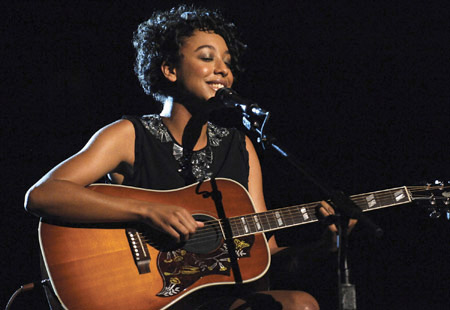
Newcomer Corinne Bailey Rae performs "Like a Star." ‡
While Abbott obviously prefers the music-inspired moments, he recognizes that it's all part of the Grammy experience. "There's not another musical show where you get this eclectic group of people assembled together. There are phenomenal moments, and there are awkward moments. Because it's live, you've got spontaneity, and you just don't get those moments on television very often."
For more photos and behind-the-scenes info, visit the Grammy photo gallery here
• • Photos courtesy of The Recording Academy, Photographs by Alexandra Wyman/WireImage (c) 2007.
‡ Photos courtesy of Kevin Mazur/WireImage.com (c) 2007.
- Log in or register to post comments






























































